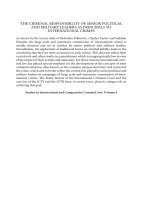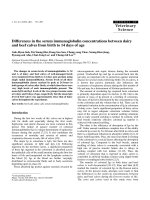The rise and fall of the great powers economic change and military conflict from 1500 to 2000
Bạn đang xem bản rút gọn của tài liệu. Xem và tải ngay bản đầy đủ của tài liệu tại đây (12.51 MB, 708 trang )
ECONOMIC CHANGE AND
MILITARY CONFLICT
FROM 1500 TO 2000
THERM:
ANDE4LL
TV G R E A T
Tai Lieu Chat Luong
FPT
$24.95
l s
Y
it that throughout history
/ some nations gain power while
others lose it? This question is
^HT^HF
y °f historical interest,
but also important for underW
W
standing today's world as the
•
•
new century dawns, for just as
the great empires of the past flourished and fell,
will today's—and tomorrow's—empires rise and
fell as well.
In this wide-ranging analysis of global politics
over the past five centuries, Ydle historian Paul
Kennedy focuses on the critical relationship of
economic to military power as it affects the rise
and fell of empires. Nations project their military
power according to their economic resources and
in defense of their broad economic interests. But,
Kennedy argues, the cost of projecting that mili
tary power is more than even the largest econo
mies can afford indefinitely, especially when new
technologies and new centers of production shift
economic power away from established Great
Powers—hence the rise and fell of nations.
Professor Kennedy begins this story around the
year 1500, when a combination of economic and
military-technological breakthroughs so strength
ened the nation-states of Europe that soon they
prevailed over the great empires of the East; but
European dynastic and religious rivalries, along
with new technologies, made it impossible for any
single power to dominate the continent. From the
campaigns of Emperor Charles V to the struggles
against Napoleonic France, victory repeatedly
went to the economically strong side, while states
that were militarily top heavy usually crashed
to eventual defeat. This is a pattern, Professor
Kennedy shows, that also applied in the two world
wars of the present century, where superior eco
nomic and technological resources twice defeated
the German war machine.
In what will probably be the most widely dis
cussed part of this book, Professor Kennedy
devotes his closing chapters to an analysis of Great
Power politics since 1945 through the year 2000.
Here, too, his focus is not only on the military
abilities and policies of the leading states, but also
^^^T
A
^^^J^^Lf
n o t
(continued on back flap)
o n r
(continued from front flap)
on those profound shifts in the world's productive
balances that—as in the Renaissance—cause cer
tain Great Powers to rise as others fall. Professor
Kennedy's discussion of the implications of these
changes for the United States, the Soviet Union,
the countries of western Europe, and the emerging
Asian powers of China and Japan makes this one
of the most important political studies of recent
time. Both for the policy maker and the general
public, The Rise and Fall of the Great Powers
transcends its historical scholarship.
Educated at the universities of Newcastle, Oxford,
and Bonn, PAUL KENNEDY is now Dilworth Pro
fessor of History at Yale University, where he
teaches modern international and strategic history.
A former research assistant to Sir Basil Liddell
Hart, he has written and edited ten books on sub
jects such as naval history, imperialism, AngloGerman relations, strategy, and diplomacy. A
visiting fellow and guest lecturer at many universi
ties, he reviews widely in daily and weekly jour
nals as well as for professional magazines. Paul
Kennedy is married, has three children, and lives
in Hamden, Connecticut.
Jacket design: Bob Silverman
Jacket art: Van Howell
Random House, Inc., New York, NY. 10022
Printed in U.S.A. 1/88
© 1988 Random House, Inc.
From
T H E R I S E A N D FALL
T&GREATPOWERS
"Although the United States is at present still in a class of its
own economically and perhaps even militarily, it cannot avoid
confronting the two great tests which challenge the longevity of
every major power that occupies the 'number one' position in
world affairs: whether, in the military/strategical realm, it can
preserve a reasonable balance between the nation's perceived
defense requirements and the means it possesses to maintain
those commitments; and whether, as an intimately related
point, it can preserve the technological and economic bases
of its power from relative erosion in the face of the ever-shift
ing patterns of global production. This test of American abili
ties will be the greater because it, like imperial Spain around
1600 or the British Empire around 1900, is the inheritor of a
vast array of strategical commitments which had been made
decades earlier, when the nation's political, economic, and mili
tary capacity to influence world affairs seemed so much
more assured. In consequence, the United States now runs the
risk, so familiar to historians of the rise and fall of previous
Great Powers, of what might roughly be called imperial
overstretch': that is to say, decision makers in Washing
ton must face the awkward and enduring fact that the sum
total of the United States' global interests and obligations is
nowadays far larger than the country's power to defend them
all simultaneously."
5 2 49 5
n
M
9 780394 546742
ISBN 0-3T4-5Mb7M-l
The Rise and Fall
of the Great Powers
ALSO BY PAUL KENNEDY
Pacific Onslaught 1941-1943
Pacific Victory 1943-1945
The Samoan Tangle
The Rise and Fall of British Naval Mastery
The Realities Behind Diplomacy
The Rise of the Anglo-German Antagonism
1860-1914
Strategy and Diplomacy
1860-1945
THE
RISE A N D FALL
OF THE
G R E A T POWERS
Economic Change
and Military Conflict
from 1500 to 2 0 0 0
BY PAUL KENNEDY
Random House
New York
Copyright © 1987 by Paul Kennedy
All rights reserved under
International and Pan-American Copyright Conventions.
Published in the United States by Random House, Inc.,
New York.
Grateful acknowledgment is made to the following
for permission to reprint previously published material:
Lexington Books, D. C. Heath and Company: An illustration from American
Defense Annual 1987-1988, edited by Joseph Kruzel. Copyright © 1987, D. C.
Heath and Company (Lexington, Mass.: Lexington Books, D. C. Heath and
Company). Reprinted by permission of the publisher.
Library of Congress Cataloging-in-Publication Data
Kennedy, Paul M., 1945The rise and fall of the great powers.
Includes index.
1. History, Modern. 2. Economic history.
3. Military history, Modern. 4. Armaments—Economic
aspects. 5. Balance of power. I. Title.
D210.K46 1988
909.82
87-9690
ISBN 0-394-54674-1
Book design by Charlotte Staub
Maps by Jean Paul Tremblay
Manufactured in the United States of America
89
To Cath
Acknowledgments
\A/hatever the weaknesses of this
book, they would have been far greater without the kind help of
friends. J. R. Jones and Gordon Lee went through the entire manu
script, asking questions all the way. My colleague Jonathan Spence
endeavored (I fear with only partial success) to curb the cultural as
sumptions which emerged in the first two chapters. John Elliott was
encouraging about Chapter 2, despite its being very evidently "not my
period." Paddy O'Brien and John Bosher sought to make my comments
on eighteenth-century British and French finance a little less crude.
Nick Rizopoulos and Michael Mandelbaum not only scrutinized the
later chapters, but also invited me to present my ideas at a series of
meetings at the Lehrman Institute in New York. Many, many scholars
have heard me give papers on subthemes in this book, and have pro
vided references, much-needed criticism, and encouragement.
The libraries and staffs at the universities of East Anglia and Yale
were of great assistance. My graduate student Kevin Smith helped me
in the search for historical statistics. My son Jim Kennedy prepared the
maps. Sheila Klein and Sue McClain came to the rescue with typing
and word processing, as did Maarten Pereboom with the bibliography.
I am extremely grateful for the sustained support and encouragement
which my literary agent, Bruce Hunter, has provided over the years.
Jason Epstein has been a firm and patient editor, repeatedly getting me
to think of the general reader—and also recognizing earlier than the
author did how demanding it would be to deal with themes of this
magnitude.
My family has provided support and, more important still, light
relief. The book is dedicated to my wife, to whom I owe so much.
Paul Kennedy
Hamden, Connecticut, 1986
vil
CONTENTS
Acknowledgments vii
Maps xi
Tables and Charts xiii
Introduction xv
STRATEGY AND ECONOMICS
IN THE PREINDUSTRIAL WORLD
1.
The Rise of the Western World 3
Ming China 4
The Muslim World 9
Two Outsiders—Japan and Russia 14
The "European Miracle" 16
2.
The Habsburg Bid for Mastery, 1519–1659 31
The Meaning and Chronology of the Struggle 32
Strengths and Weaknesses of the Habsburg Bloc 41
International Comparisons 55
War, Money, and the Nation-State 70
3.
Finance, Geography, and the Winning of Wars, 1660–1815 73
The "Financial Revolution" 76
Geopolitics 86
The Winning of Wars, 1660–1763 100
The Winning of Wars, 1763–1815 115
STRATEGY AND ECONOMICS
IN THE INDUSTRIAL ERA
4.
Industrialization and the Shifting Global Balances, 1815–1885 143
The Eclipse of the Non-European World 147
Britain as Hegemon? 151
The "Middle Powers" 158
The Crimean War and the Erosion of Russian Power 170
ix
CONTENTS
X
The United States and the Civil War 178
The Wars of German Unification 182
Conclusions 191
5.
The Coming of a Bipolar World and the Crisis
of the "Middle Powers": Part One, 1885–1918 194
The Shifting Balance of World Forces 198
The Position of the Powers, 1885–1914 202
Alliances and the Drift to War, 1890–1914 249
Total War and the Power Balances, 1914–1918 256
6.
The Coming of a Bipolar World and the Crisis
of the "Middle Powers": Part Two, 1919–1942 275
The Postwar International Order 275
The Challengers 291
The Offstage Superpowers 320
The Unfolding Crisis, 1931–1942 333
STRATEGY AND ECONOMICS
TODAY AND TOMORROW
7.
Stability and Change in a Bipolar World, 1943–1980 347
"The Proper Application of Overwhelming Force" 347
The New Strategic Landscape 357
The Cold War and the Third World 373
The Fissuring of the Bipolar World 395
The Changing E c o n o m i c Balances, 1950 to 1980 413
8.
To the Twenty-first Century 438
History and Speculation 438
China's Balancing Act 447
The Japanese Dilemma 458
The EEC—Potential and Problems 471
The Soviet Union and Its "Contradictions" 488
The United States: The Problem of Number One in Relative Decline 514
Epilogue 536
Notes 541
Bibliography 625
Index 663
MAPS
1.
2.
3.
4.
5.
6.
7.
8.
9.
10.
11.
12.
World Power Centers in the Sixteenth Century 5
The Political Divisions of Europe in the Sixteenth Century
Charles V's Inheritance, 1519 34
The Collapse of Spanish Power in Europe 42
Europe in 1721 109
European Colonial Empires, c. 1750 112
Europe at the Height of Napoleon's Power, 1810 128
The Chief Possessions, Naval Bases, and Submarine Cables
of the British Empire, c. 1900 225
The European Powers and Their War Plans in 1914 255
Europe After the First World War 276
Europe at the Height of Hitler's Power, 1942 351
Worldwide U.S. Force Deployments, 1987 520
xi
TABLES se CHARTS
TABLES
1.
2.
3.
4.
5.
6.
7.
8.
9.
10.
11.
12.
13.
14.
15.
16.
17.
18.
19.
20.
21.
22.
23.
24.
Increase in Military Manpower, 1470–1660 56
British Wartime Expenditure and Revenue, 1688–1815 81
Populations of the Powers, 1700–1800 99
Size of Armies, 1690–1814 99
Size of Navies, 1689–1815 99
Relative Shares of World Manufacturing Output, 1750–1900 149
Per Capita Levels of Industrialization, 1750–1900 149
Military Personnel of the Powers, 1816–1880 154
GNP of the European Great Powers, 1830–1890 171
Per Capita GNP of the European Great Powers, 1830–1890 171
Military Expenditures of the Powers in the Crimean War 176
Total Population of the Powers, 1890–1938 199
Urban Population of the Powers and as Percentage of the Total
Population, 1890–1938 200
Per Capita Levels of Industrialization, 1880–1938 200
Iron/Steel Production of the Powers, 1890–1938 200
Energy Consumption of the Powers, 1890–1938 201
Total Industrial Potential of the Powers in Relative Perspective,
1880–1938 201
Relative Shares of World Manufacturing Output,
1880–1938 202
Military and Naval Personnel of the Powers, 1880–1914 203
Warship Tonnage of the Powers, 1880–1914 203
National Income, Population, and per Capita Income of the
Powers in 1914 243
Industrial/Technological Comparisons of the 1914
Alliances 258
U.K. Munitions Production, 1914–1918 267
Industrial/Technological Comparisons with the United States
but Without Russia 271
xffl
xlv
25.
26.
27.
28.
29.
30.
31.
32.
33.
34.
35.
36.
37.
38.
39.
40.
41.
42.
43.
44.
45.
46.
47.
48.
49.
TABLES
War Expenditure and Total Mobilized Forces, 1914–1919 274
World Indices of Manufacturing Production, 1913–1925 280
Defense Expenditures of the Great Powers, 1930–1938 296
Annual Indices of Manufacturing Production, 1913–1938 299
Aircraft Production of the Powers, 1932–1939 324
Shares of World Manufacturing Output, 1929–1938 330
National Income of the Powers in 1937 and Percentage Spent
on Defense 332
Relative War Potential of the Powers in 1937 332
Tank Production in 1944 353
Aircraft Production of the Powers, 1939–1945 354
Armaments Production of the Powers, 1940–1943 355
Total GNP and per Capita GNP of the Powers in 1950 369
Defense Expenditures of the Powers, 1948–1970 384
Nuclear Delivery Vehicles of the Powers, 1974 395
Production of World Manufacturing Industries, 1830–1980 414
Volume of World Trade, 1850–1971 414
Percentage Increases in World Production, 1948–1968 415
Average Annual Rate of Growth of Output per Capita,
1948–1962 433
Shares of Gross World Product, 1960–1980 436
Population, GNP per Capita, and GNP in 1980 436
Growth in Real GNP, 1979–1983 474
Kilos of Coal Equivalent and Steel Used to Produce $1,000 of
GDP in 1979–1980 493
Estimated Strategic Nuclear Warheads 503
NATO and Warsaw Pact Naval Strengths 511
U.S. Federal Deficit, Debt, and Interest, 1980–1985 527
CHARTS
1. The Relative Power of Russia and Germany 242
2. GDP Projections of China, India, and Certain Western European
States, 1980–2020 455
3. Grain Production in the Soviet Union and China,
1950–1984 492
Introduction
This is a book about national and
international power in the "modern"—that is, post-Renaissance—pe
riod. It seeks to trace and to explain how the various Great Powers have
risen and fallen, relative to each other, over the five centuries since the
formation of the "new monarchies" of western Europe and the begin
nings of the transoceanic, global system of states. Inevitably, it con
cerns itself a great deal with wars, especially those major, drawn-out
conflicts fought by coalitions of Great Powers which had such an im
pact upon the international order; but it is not strictly a book about
military history. It also concerns itself with tracing the changes which
have occurred in the global economic balances since 1500; and yet it
is not, at least directly, a work of economic history. What it concen
trates upon is the interaction between economics and strategy, as each
of the leading states in the international system strove to enhance its
wealth and its power, to become (or to remain) both rich and strong.
The "military conflict" referred to in the book's subtitle is therefore
always examined in the context of "economic change." The triumph of
any one Great Power in this period, or the collapse of another, has
usually been the consequence of lengthy fighting by its armed forces;
but it has also been the consequence of the more or less efficient
utilization of the state's productive economic resources in wartime,
and, further in the background, of the way in which that state's econ
omy had been rising or falling, relative to the other leading nations,
in the decades preceding the actual conflict. For that reason, how a
Great Power's position steadily alters in peacetime is as important to
this study as how it fights in wartime.
The argument being offered here will receive much more elaborate
analysis in the text itself, but can be summarized very briefly:
The relative strengths of the leading nations in world affairs never
remain constant, principally because of the uneven rate of growth
among different societies and of the technological and organizational
breakthroughs which bring a greater advantage to one society than to
XV
xvi
INTRODUCTION
another. For example, the coming of the long-range gunned sailing
ship and the rise of the Atlantic trades after 1500 was not uniformly
beneficial to all the states of Europe—it boosted some much more than
others. In the same way, the later development of steam power and of
the coal and metal resources upon which it relied massively increased
the relative power of certain nations, and thereby decreased the rela
tive power of others. Once their productive capacity was enhanced,
countries would normally find it easier to sustain the burdens of pay
ing for large-scale armaments in peacetime and of maintaining and
supplying large armies and fleets in wartime. It sounds crudely mercantilistic to express it this way, but wealth is usually needed to under
pin military power, and military power is usually needed to acquire
and protect wealth. If, however, too large a proportion of the state's
resources is diverted from wealth creation and allocated instead to
military purposes, then that is likely to lead to a weakening of national
power over the longer term. In the same way, if a state overextends
itself strategically—by, say, the conquest of extensive territories or the
waging of costly wars—it runs the risk that the potential benefits from
external expansion may be outweighed by the great expense of it all—a
dilemma which becomes acute if the nation concerned has entered a
period of relative economic decline. The history of the rise and later
fall of the leading countries in the Great Power system since the ad
vance of western Europe in the sixteenth century—that is, of nations
such as Spain, the Netherlands, France, the British Empire, and cur
rently the United States—shows a very significant correlation over the
longer term between productive and revenue-raising capacities on the
one hand and military strength on the other.
The story of "the rise and fall of the Great Powers" which is pre
sented in these chapters may be briefly summarized here. The first
chapter sets the scene for all that follows by examining the world
around 1500 and by analyzing the strengths and weaknesses of each of
the "power centers" of that time—Ming China; the Ottoman Empire
and its Muslim offshoot in India, the Mogul Empire; Muscovy;
Tokugawa Japan; and the cluster of states in west-central Europe. At
the beginning of the sixteenth century it was by no means apparent
that the last-named region was destined to rise above all the rest. But
however imposing and organized some of those oriental empires ap
peared by comparison with Europe, they all suffered from the conse
quences of having a centralized authority which insisted upon a
uniformity of belief and practice, not only in official state religion but
also in such areas as commercial activities and weapons development.
The lack of any such supreme authority in Europe and the warlike
rivalries among its various kingdoms and city-states stimulated a con
stant search for military improvements, which interacted fruitfully
with the newer technological and commercial advances that were also
INTRODUCTION
xvli
being thrown up in this competitive, entrepreneurial environment.
Possessing fewer obstacles to change, European societies entered into
a constantly upward spiral of economic growth and enhanced military
effectiveness which, over time, was to carry them ahead of all other
regions of the globe.
While this dynamic of technological change and military competi
tiveness drove Europe forward in its usual jostling, pluralistic way,
there still remained the possibility that one of the contending states
might acquire sufficient resources to surpass the others, and then to
dominate the continent. For about 150 years after 1500, a dynasticreligious bloc under the Spanish and Austrian Habsburgs seemed to
threaten to do just that, and the efforts of the other major European
states to check this "Habsburg bid for mastery" occupy the whole of
Chapter 2. As is done throughout this book, the strengths and weak
nesses of each of the leading Powers are analyzed relatively, and in the
light of the broader economic and technological changes affecting
western society as a whole, in order that the reader can understand
better the outcome of the many wars of this period. The chief theme
of this chapter is that despite the great resources possessed by the
Habsburg monarchs, they steadily overextended themselves in the
course of repeated conflicts and became militarily top-heavy for their
weakening economic base. If the other European Great Powers also
suffered immensely in these prolonged wars, they managed—though
narrowly—to maintain the balance between their material resources
and their military power better than their Habsburg enemies.
The Great Power struggles which took place between 1660 and
1815, and are covered in Chapter 3, cannot be so easily summarized as
a contest between one large bloc and its many rivals. It was in this
complicated period that while certain former Great Powers like Spain
and the Netherlands were falling into the second rank, there steadily
emerged five major states (France, Britain, Russia, Austria, and
Prussia) which came to dominate the diplomacy and warfare of eigh
teenth-century Europe, and to engage in a series of lengthy coalition
wars punctuated by swiftly changing alliances. This was an age in
which France, first under Louis XIV and then later under Napoleon,
came closer to controlling Europe than at any time before or since; but
its endeavors were always held in check, in the last resort at least, by
a combination of the other Great Powers. Since the cost of standing
armies and national fleets had become horrendously great by the early
eighteenth century, a country which could create an advanced system
of banking and credit (as Britain did) enjoyed many advantages over
financially backward rivals. But the factor of geographical position
was also of great importance in deciding the fate of the Powers in their
xviii
INTRODUCTION
many, and frequently changing, contests—which helps to explain why
the two "flank" nations of Russia and Britain had become much more
important by 1815. Both retained the capacity to intervene in the strug
gles of west-central Europe while being geographically sheltered from
them; and both expanded into the extra- European world as the eigh
teenth century unfolded, even as they were ensuring that the continen
tal balance of power was upheld. Finally, by the later decades of the
century, the Industrial Revolution was under way in Britain, which
was to give that state an enhanced capacity both to colonize overseas
and to frustrate the Napoleonic bid for European mastery.
For an entire century after 1815, by contrast, there was a remark
able absence of lengthy coalition wars. A strategic equilibrium existed,
supported by all of the leading Powers in the Concert of Europe, so that
no single nation was either able or willing to make a bid for domi
nance. The prime concerns of government in these post-1815 decades
were with domestic instability and (in the case of Russia and the
United States) with further expansion across their continental landmasses. This relatively stable international scene allowed the British
Empire to rise to its zenith as a global power, in naval and colonial and
commercial terms, and also interacted favorably with its virtual mo
nopoly of steam-driven industrial production. By the second half of the
nineteenth century, however, industrialization was spreading to cer
tain other regions, and was beginning to tilt the international power
balances away from the older leading nations and toward those coun
tries with both the resources and organization to exploit the newer
means of production and technology. Already, the few major conflicts
of this era—the Crimean War to some degree but more especially the
American Civil War and the Franco-Prussian War—were bringing de
feat upon those societies which failed to modernize their military sys
tems, and which lacked the broad-based industrial infrastructure to
support the vast armies and much more expensive and complicated
weaponry now transforming the nature of war.
As the twentieth century approached, therefore, the pace of techno
logical change and uneven growth rates made the international system
much more unstable and complex than it had been fifty years earlier.
This was manifested in the frantic post-1880 jostling by the Great Pow
ers for additional colonial territories in Africa, Asia, and the Pacific,
partly for gain, partly out of a fear of being eclipsed. It also manifested
itself in the increasing number of arms races, both on land and at sea,
and in the creation of fixed military alliances, even in peacetime, as the
various governments sought out partners for a possible future war.
Behind the frequent colonial quarrels and international crises of the
pre-1914 period, however, the decade-by-decade indices of economic
power were pointing to even more fundamental shifts in the global
balances—indeed, to the eclipse of what had been, for over three centu-
INTRODUCTION
xix
ries, essentially a Eurocentric world system. Despite their best efforts,
traditional European Great Powers like France and Austria-Hungary,
and a recently united one like Italy, were falling out of the race. By
contrast, the enormous, continent-wide states of the United States and
Russia were moving to the forefront, and this despite the inefficiencies
of the czarist state. Among the western European nations only Ger
many, possibly, had the muscle to force its way into the select league
of the future world Powers. Japan, on the other hand, was intent upon
being dominant in East Asia, but not farther afield. Inevitably, then, all
these changes posed considerable, and ultimately insuperable, prob
lems for a British Empire which now found it much more difficult to
defend its global interests than it had a half-century earlier.
Although the major development of the fifty years after 1900 can
thus be seen as the coming of a bipolar world, with its consequent crisis
for the "middle" Powers (as referred in the titles of Chapters 5 and 6),
this metamorphosis of the entire system was by no means a smooth
one. On the contrary, the grinding, bloody mass battles of the First
World War, by placing a premium upon industrial organization and
national efficiency, gave imperial Germany certain advantages over
the swiftly modernizing but still backward czarist Russia. Within a few
months of Germany's victory on the eastern front, however, it found
itself facing defeat in the west, while its allies were similarly collapsing
in the Italian, Balkan, and Near Eastern theaters of the war. Because
of the late addition of American military and especially economic aid,
the western alliance finally had the resources to prevail over its rival
coalition. But it had been an exhausting struggle for all the original
belligerents. Austria-Hungary was gone, Russia in revolution, Ger
many defeated; yet France, Italy, and even Britain itself had also suf
fered heavily in their victory. The only exceptions were Japan, which
further augmented its position in the Pacific; and, of course, the United
States, which by 1918 was indisputably the strongest Power in the
world.
The swift post-1919 American withdrawal from foreign engage
ments, and the parallel Russian isolationism under the Bolshevik re
gime, left an international system which was more out of joint with the
fundamental economic realities than perhaps at any time in the five
centuries covered in this book. Britain and France, although weak
ened, were still at the center of the diplomatic stage, but by the 1930s
their position was being challenged by the militarized, revisionist
states of Italy, Japan, and Germany—the last intent upon a much more
deliberate bid for European hegemony than even in 1914. In the back
ground, however, the United States remained by far the mightiest
manufacturing nation in the world, and Stalin's Russia was quickly
XX
INTRODUCTION
transforming itself into an industrial superpower. Consequently, the
dilemma for the revisionist "middle" Powers was that they had to
expand soon if they were not to be overshadowed by the two continen
tal giants. The dilemma for the status quo middle Powers was that in
fighting off the German and Japanese challenges, they would most
likely weaken themselves as well. The Second World War, for all its
ups and downs, essentially confirmed those apprehensions of decline.
Despite spectacular early victories, the Axis nations could not in the
end succeed against an imbalance of productive resources which was
far greater than that of the 1914-1918 war. What they did achieve was
the eclipse of France and the irretrievable weakening of Britain—
before they themselves were overwhelmed by superior force. By 1943,
the bipolar world forecast decades earlier had finally arrived, and the
military balance had once again caught up with the global distribution
of economic resources.
The last two chapters of this book examine the years in which a
bipolar world did indeed seem to exist, economically, militarily, and
ideologically—and was reflected at the political level by the many
crises of the Cold War. The position of the United States and the USSR
as Powers in a class of their own also appeared to be reinforced by the
arrival of nuclear weapons and long-distance delivery systems, which
suggested that the strategic as well as the diplomatic landscape was
now entirely different from that of 1900, let alone 1800.
And yet the process of rise and fall among the Great Powers—of
differentials in growth rates and technological change, leading to shifts
in the global economic balances, which in turn gradually impinge
upon the political and military balances—had not ceased. Militarily,
the United States and the USSR stayed in the forefront as the 1960s
gave way to the 1970s and 1980s. Indeed, because they both interpreted
international problems in bipolar, and often Manichean, terms, their
rivalry has driven them into an ever-escalating arms race which no
other Powers feel capable of matching. Over the same few decades,
however, the global productive balances have been altering faster than
ever before. The Third World's share of total manufacturing output
and GNP, depressed to an all-time low in the decade after 1945, has
steadily expanded since that time. Europe has recovered from its war
time batterings and, in the form of the European Economic Commu
nity, has become the world's largest trading unit. The People's
Republic of China is leaping forward at an impressive rate. Japan's
postwar economic growth has been so phenomenal that, according to
some measures, it recently overtook Russia in total GNP. By contrast,
both the American and Russian growth rates have become more slug
gish, and their shares of global production and wealth have shrunk
dramatically since the 1960s. Leaving aside all the smaller nations,
INTRODUCTION
xxi
therefore, it is plain that there already exists a multipolar world once
more, if one measures the economic indices alone. Given this book's
concern with the interaction between strategy and economics, it
seemed appropriate to offer a final (if necessarily speculative) chapter
to explore the present disjuncture between the military balances and
the productive balances among the Great Powers; and to point to the
problems and opportunities facing today's five large politico-economic
"power centers"—China, Japan, the EEC, the Soviet Union, and the
United States itself—as they grapple with the age-old task of relating
national means to national ends. The history of the rise and fall of the
Great Powers has in no way come to a full stop.
Since the scope of this book is so large, it is clear that it will be read
by different people for different purposes. Some readers will find here
what they had hoped for: a broad and yet reasonably detailed survey
of Great Power politics over the past five centuries, of the way in which
the relative position of each of the leading states has been affected by
economic and technological change, and of the constant interaction
between strategy and economics, both in periods of peace and in the
tests of war. By definition, it does not deal with small Powers, nor
(usually) with small, bilateral wars. By definition also, the book is
heavily Eurocentric, especially in its middle chapters. But that is only
natural with such a topic.
To other readers, perhaps especially those political scientists who
are now so interested in drawing general rules about "world systems"
or the recurrent pattern of wars, this study may offer less than what
they desire. To avoid misunderstanding, it ought to be made clear at
this point that the book is not dealing with, for example, the theory that
major (or "systemic") wars can be related to Kondratieff cycles of
economic upturn and downturn. In addition, it is not centrally con
cerned with general theories about the causes of war, and whether they
are likely to be brought about by "rising" or "falling" Great Powers. It
is also not a book about theories of empire, and about how imperial
control is effected (as is dealt with in Michael Doyle's recent book
Empires), or whether empires contribute to national strength. Finally,
it does not propose any general theory about which sorts of society and
social/governmental organizations are the most efficient in extracting
resources in time of war.
On the other hand, there obviously is a wealth of material in this
book for those scholars who wish to make such generalizations (and
one of the reasons why there is such an extensive array of notes is to
indicate more detailed sources for those readers interested in, say, the
financing of wars). But the problem which historians—as opposed to
political scientists—have in grappling with general theories is that the
evidence of the past is almost always too varied to allow for "hard"









